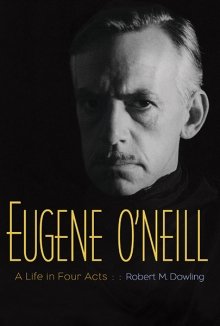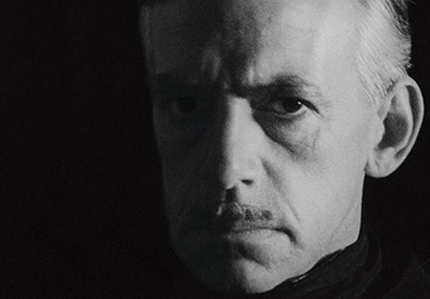100 Years after the Discovery of Eugene O’Neill, “Hughie” and “Long Day’s Journey Into Night” Open on Broadway
Hughie begins performances on February 8 at Broadway’s Booth Theatre and Long Day’s Journey Into Night begins performance on March 31 at Broadway’s American Airlines Theatre
Robert M. Dowling—
Not long ago, on the 123rd anniversary of Eugene O’Neill’s birth, I attended the Irish American Writers and Artists organization’s festivities for their annual Eugene O’Neill Lifetime Achievement Award, a short walk from where the playwright was born on Times Square. The award is conferred upon the “writer, actor, musician or other artist” who advances the stature of Irish-American culture. (That year’s recipients were Ciarán O’Reilly and Charlotte Moore, co-founders of Off-Broadway’s Irish Repertory Theatre.) At the coat check, I found myself wedged in line behind Irish stage and screen star, and confirmed Eugene O’Neill virtuoso, Gabriel Byrne.
I had attended two of Byrne’s triumphs on Broadway, O’Neill’s A Touch of the Poet and A Moon for the Misbegotten, and mentioned that his performance in A Touch of the Poet instantly placed that work, for me, at the top of O’Neill’s over fifty published plays. I asked what was next on his bucket list, now that he’d arisen as one of the playwright’s truly great male leads. Byrne responded softly but without hesitation: “James Tyrone,” the character based on O’Neill’s father James O’Neill in the playwright’s autobiographical masterwork Long Day’s Journey Into Night.
Byrne is soon to fulfill his wish. This April, for the Roundabout Theatre Company’s revival of Long Day’s Journey, he’ll play the pater familias among a superbly well-cast ensemble with Jessica Lange as Mary Tyrone (O’Neill’s mother), Michael Shannon as Jamie Tyrone (his ne’er-do-well older brother), and John Gallagher Jr. as Edmund Tyrone (the playwright himself). Meanwhile, Oscar-winning actor and director Forrest Whitaker is currently in rehearsals for his Broadway debut this February, opposite Tony-winner Frank Wood, with another fabled O’Neill role: the washed-up gambler “Erie” Smith in Hughie. If there’s a more optimal part for Whitaker to make his first Broadway appearance, I don’t know it.
The 2016 spring season, then, will mark the first time since 1988 that two O’Neill revivals are appearing on Broadway concurrently. 1988 was the centennial of O’Neill’s birth, and the pairing was Long Day’s Journey and its comedic double Ah, Wilderness! (These were done in repertory with the master interpreters of O’Neill, Jason Robards and Colleen Dewhurst.) A host of other O’Neill productions will be opening this year as well, including the Court Theatre’s own Long Day’s Journey Into Night in Chicago this March, with Harris Yulin as James Tyrone and directed by the Pulitzer-Prize-winning playwright David Auburn, and events like the “O’Neill 100 Reading Series” and this year’s O’Neill-oriented Tennessee Williams Theater Festival, both to take place in Provincetown, Massachusetts. Tony Kushner, a self-professed “O’Neill fanatic,” also recently revealed that he’s at work on a screenplay based on his predecessor’s life.
A twenty-first-century O’Neill renaissance has been distilling for over a decade. American and international audiences alike have shown a voracious appetite for more of his plays, and there’s no end in sight for this playwright’s potential to speak to contemporary audiences as he once spoke to his own. The pungent cask of O’Neill’s incomparable oeuvre is now being fully tapped, and it’s happening right on time for a centennial at least as significant as O’Neill’s birth. If centennials and anniversaries are to be valued at all, this one is immense for O’Neill devotees.
Eugene Gladstone O’Neill, winner of four Pulitzer Prizes and to date the only American dramatist to win the Nobel Prize in Literature, was born on October 16, 1888, at the Barrett House hotel in midtown Manhattan. Towering over the northeast corner of Broadway and Forty-Third Street, the Barrett was, in one of history’s great ironies, located at what would become Times Square, the theatrical center of the world.
O’Neill’s birth as a playwright, however, took place in Provincetown, Massachusetts, on July 28, 1916, with the dramatist’s humble but now legendary world premiere with his one-act sea play Bound East for Cardiff. When we take into account O’Neill’s venerable stature as America’s foremost playwright, the year 2016 signals not only the centennial of his arrival as a playwright, but of modern American drama as we know it.
“The Great Provincetown Summer,” as the painter Marsden Hartley had christened the period, is one of those a twice-told origin stories with the rare distinction of being true:
In June of 1916, a twenty-seven-year old “Gene” O’Neill landed in Provincetown carrying a box of his original plays. Printed across the top, incredibly, were the words “Magic Yeast.” Soon after his arrival at the remote fishing village on the tip of Cape Cod, then as now a popular refuge for artists and bohemians, O’Neill teamed up with the experimental theater group known as the Provincetown Players. After an initial reading of his one-act Hollywood farce The Movie Man, which embarrassingly flopped, O’Neill pitched them another script, Bound East for Cardiff.
One of the Players, the poet Harry Kemp, reported years later that “this time,” while O’Neill read the one-act play “in his low, deep, slightly monotonous but compelling voice,” “We heard the actual speech of men who go to sea; we shared the reality of their lives; we felt the motion and windy, wave-beaten urge of a ship.” O’Neill conjured seamen’s banter, foreign dialects, and a detailed maritime setting for atmosphere. But he also invoked a profound sympathy for an American type, the working-class sailor, that had been voiceless up to then on the world stage.
“This time,” Kemp said, “no one doubted that here was a genuine playwright.”
Paying tribute to the suffering of outsiders in American life became a lifelong project for O’Neill, one he would explore over the years to come with his treatment of a redeemed prostitute in “Anna Christie,” a black Pullman porter in The Emperor Jones, a coal-stoker on a steamship in The Hairy Ape (just performed to great praise this fall at London’s The Old Vic), and one he would perfect over the decades to come, culminating in full with The Iceman Cometh (also recently revived, with Nathan Lane and Brian Dennehy, at the Brooklyn Academy of Music), Hughie, A Touch of the Poet, Long Day’s Journey Into Night, and A Moon for the Misbegotten.
Hughie and Long Day’s Journey Into Night were both written in 1941, at the very end of O’Neill’s writing career (and, astonishingly, years after O’Neill had already won the Nobel Prize in Literature in 1936). Hughie was composed in just three weeks that April, a couple of months before he completed Long Day’s Journey. It was to be the “last in time” for a planned series of between six and nine one-act plays O’Neill called “By Way of Obit.” (Hughie is the sole surviving installment.) “In each,” O’Neill said, “the main character talks about a person who has died to a person who does little but listen.” Hughie is set in 1928 during what O’Neill called “the Great Hollow Boom” of the 1920s. The action takes place exclusively in the lobby of a cut-rate hotel in Manhattan’s theater district and treats the inner and outer lives of a desk clerk named Charlie Hughes (the listener) and a two-bit Broadway hustler, “Erie” Smith (the talker).
Erie finds meager solace in his gambling and alcohol habits, as they are short-term solutions to the long-term torments of isolation and disillusionment. He is mourning the loss of his friend Hughie, the hotel’s recently deceased desk clerk. Charlie, Hughie’s replacement, tunes out everything but the sounds of the street outside, musing that any menial job would be more exciting than his own. But Erie requires a “sucker” like his departed friend Hughie to sustain his delusion of self-confidence and luck in gambling. “If everybody along Broadway who kids himself was to drop dead,” Erie says, “there wouldn’t be nobody left.” The play’s dramatic tension hinges on Erie’s desperate attempt to break Charlie’s weariness with any human contact. In the end, they settle upon mutually beneficial fantasies impossible to sustain without the other.
O’Neill finished his four-act magnum opus Long Day’s Journey Into Night a few months later, and only a select few read the script during his lifetime. “When he started [the play],” his third wife Carlotta Monterey remembered, “it was a most strange experience to watch that man being tortured every day by his own writing. He would come out of his study at the end of a day gaunt and sometimes weeping. His eyes would be all red and he looked ten years older than when he went in in the morning.” O’Neill made it clear that he never wanted Long Day’s Journey, far and away his most personal work, produced for stage, screen, television, or radio. Its book release, he insisted to his publishers at Random House, was not to take place until 25 years after his death.
But in 1956, only three years after O’Neill’s passing, Carlotta Monterey defied his wishes by wrenching control of the script from Random House and permitting Long Day’s Journey Into Night to be published by Yale University Press and then produced, first at the Royal Theatre in Sweden and then in New Haven for a trial run before its Broadway premiere. Monterey’s betrayal of her husband’s injunction was a sordid drama behind the drama, but few today dispute the fact that for American theater history, Monterey had undeniably made the right choice.
“He fell silent,” wrote Tony Kushner, “isolated himself, withered and died. And rose again, almost immediately!” The epic family drama won O’Neill a posthumous Pulitzer Prize, his fourth, and ignited an O’Neill renaissance over the 1950s, 60s, and 70s. “The tallest skyscraper in New York,” hailed the London’s Sunday Times in 1958, “is the reputation of Eugene O’Neill.”
Long Day’s Journey unfolds over a single day in August 1912, in the sitting room of O’Neill’s family home, Monte Cristo Cottage in New London, Connecticut. The Tyrones of the play, based on his actual family, James, Mary “Ella,” James Jr., and himself, act out against one another in a vicious warfare of recrimination. Over the action of the play, the audience begins to recognize, as he outlined in his work diary, “shifting alliances in battle”: “Father, two sons versus Mother; Mother, two sons versus Father; Father, younger son versus Mother, older son; Mother, younger son versus Father, older son; Father and Mother versus two sons; Brother versus brother; Father versus Mother.” What begin as mere skirmishes of passive aggression, escalate by the fourth act into horrific psychological carnage. No truce has been achieved in the end, only resignation.
For decades, the Tyrones have suppressed their emotional torments by condemning the other three; and when blame fails, they turn to stimulants—Mary to morphine, James to real estate, Edmund to poetry written by “whoremongers and degenerates,” Jamie to the comfort of overweight prostitutes, and all three men to whiskey. Overarching each utterance in Long Day’s Journey is the terrifying surety of a wasted past. “At the final curtain,” O’Neill said, “there they still are, trapped within each other by the past, each guilty and at the same time innocent, scorning, loving, pitying each other, understanding and yet not understanding at all, forgiving but still doomed never to be able to forget.”
The ghost of the playwright is a tangible presence during the play’s best performances. Few artists, no matter their stature, have achieved this level of immortality in a single work. In this drama, the ghost of the dead playwright is the protagonist.
Long Day’s Journey and Hughie may not at first seem well-matched for a single season: The first recounts a decades-long domestic hell, the second is an hour-long monologue by a down-and-out gambler. All six of the principal characters, however, as with the majority of the O’Neill canon, are tortured by a tragic doubleness: the lives they wish they had lived, and the lives created by forces beyond their control—familial, psychological, historical, religious, and on it goes. The good news for producers is that O’Neill offers two incarnations for the price of one Equity actor. The bad news for actors is that performing the tragic tension between dream-self and reality-self is one of the greatest challenges in modern drama. It’s also one of its greatest rewards. As with all of O’Neill’s finest plays, no matter what they accomplish for themselves and their Broadway audiences, the playwright’s presence will be felt among them, a ghost at the stage door.
Robert M. Dowling’s biography Eugene O’Neill: A Life in Four Acts, from which portions of this article have been drawn, was named a Los Angeles Times Book Prize Finalist for 2014 and will be released in paperback this March.
Further reading:



























